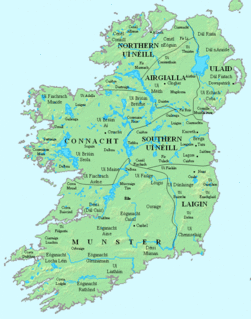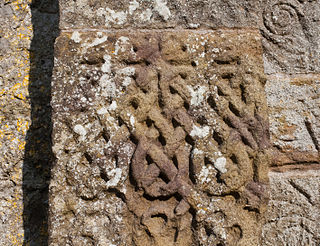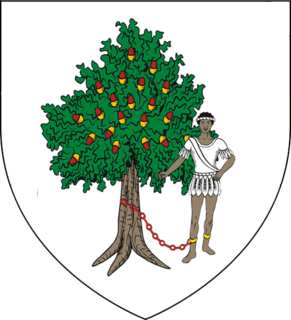Cathal mac Tadg was King of Connacht, 973.

Congal Cennmagair was High King of Ireland. He belonged to the northern Cenél Conaill branch of the Uí Néill. His father, Fergus Fanát, was not a high king, although his grandfather, Domnall mac Áedo, was counted as a High King of Ireland.
Loingsech mac Óengusso was an Irish king who was High King of Ireland. Loingsech was a member of the northern Cenél Conaill branch of the Uí Néill. Although his father Óengus had not been High King, his grandfather Domnall mac Áedo had been.
Colmán mac Cobthaig was a king of Connacht from the Ui Fiachrach branch of the Connachta. He was the first king of Connacht from the Ui Fiachrach Aidhne branch. This branch was descended from Eochu, the brother of Ailill Molt. According to the Book of Ballymote he was the grandson of Goibnenn mac Conaill (flor.537), the first Aidne king mentioned in the annals, but Rawlinson Genealogies name his grandfather as Gabrán.
Faílbe Flann mac Áedo Duib was a King of Munster from the Eóganacht Chaisil branch of the Eoganachta. He succeeded Cathal mac Áedo Flaind Chathrach of the Glendamnach branch in 628. He was the younger brother of a previous king Fíngen mac Áedo Duib. His sobriquet Flann meant "blood-red".
Crimthann mac Áedo was a King of Leinster from the Uí Máil branch of the Laigin. He was the son of Áed Dibchine mac Senaig, a previous king. He would have succeeded sometime after the death of Rónán mac Colmáin. His brother Rónán Crach was possibly the Leinster king mentioned in the saga "Fingal Rónáin" and is also said to have been a bishop who was slain by Crimthann.
Fáelán mac Colmáin was a King of Leinster from the Uí Dúnlainge branch of the Laigin. He was the son of Colmán Már mac Coirpri, a previous king. Faelan was the founder of the true fortunes of the Ui Dunlainge dynasty.
Fergus mac Colmáin was a King of Uisnech in Mide, Ireland, of the Clann Cholmáin. He was the son of Colmán Már mac Diarmato and brother of Suibne mac Colmáin, also kings of Uisnech. He ruled Uisnech from 600 to 618.
Ailill Cruitire mac Áedo Sláine was a King of Brega from the Síl nÁedo Sláine branch of the southern Ui Neill. He was the son of the high king Áed Sláine mac Diarmato. His byname meant "harper".
Máel Dóid mac Suibni was a King of Uisnech in Mide of the Clann Cholmáin. He was the son Suibne mac Colmáin and brother of Conall Guthbinn mac Suibni, previous kings. He ruled from 635 to 653.
Amalgaid mac Congalaig was a King of Brega from the Uí Chonaing sept of Cnogba (Knowth) of the Síl nÁedo Sláine branch of the southern Ui Neill. He was the son of Congalach mac Conaing Cuirre. He ruled in north Brega from 702 to 718.
Flann mac Áedo was a King of Fir Cúl in Brega of the Síl nDlúthaig sept of the Síl nÁedo Sláine of Brega. He was the son of Áed mac Dlúthaig, King of Fir Cúl and great-grandson of Ailill Cruitire mac Áedo Sláine, a king of Brega.
Flann mac Congalaig was a King of Brega from the Uí Chonaing sept of Cnogba (Knowth) of the Síl nÁedo Sláine branch of the southern Ui Neill. He was the son of Congalach mac Conaing, a previous king. He ruled from 786 to 812.
Conchobar mac Taidg Mór was a King of Connacht from the Uí Briúin branch of the Connachta. He was the grandson of Muirgius mac Tommaltaig, a previous king. His father Tadg Mór had been slain fighting in Muirgius' wars versus the minor tribes of Connacht. He was of the Síl Muiredaig sept of the Uí Briúin. The Ó Conchobhair septs of Connacht are named for him.
Áed mac Conchobair was a King of Connacht from the Uí Briúin branch of the Connachta. He was the son of Conchobar mac Taidg Mór, the previous king and was the first of his three sons to rule in succession. He was of the Síl Muiredaig sept of the Uí Briúin. He ruled from 882-888.
Seachnasach was the 17th king of the Uí Maine.
Domnall Mór Ua Cellaigh, 42nd King of Uí Maine and 9th Chief of the Name, died 1221.
Inreachtach mac Dluthach, 21st King of Uí Maine, died 750.
Mughroin mac Sochlachan was 30th King of Uí Maine, died 904).






